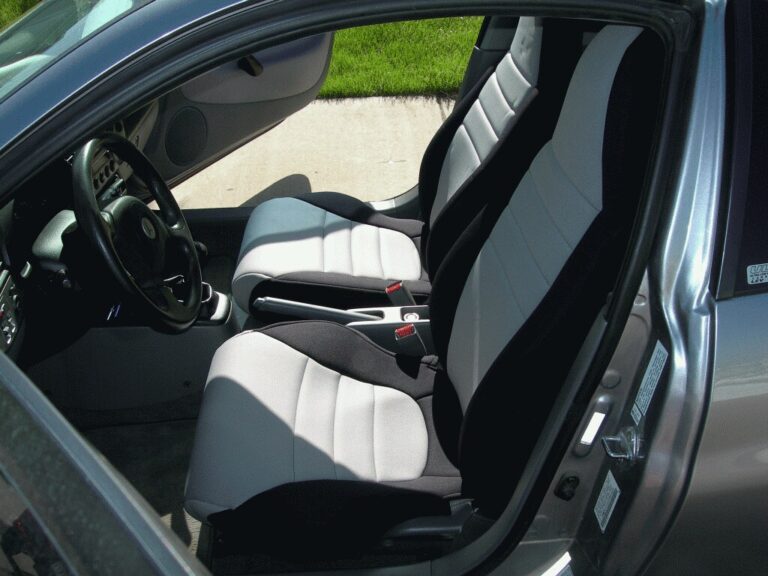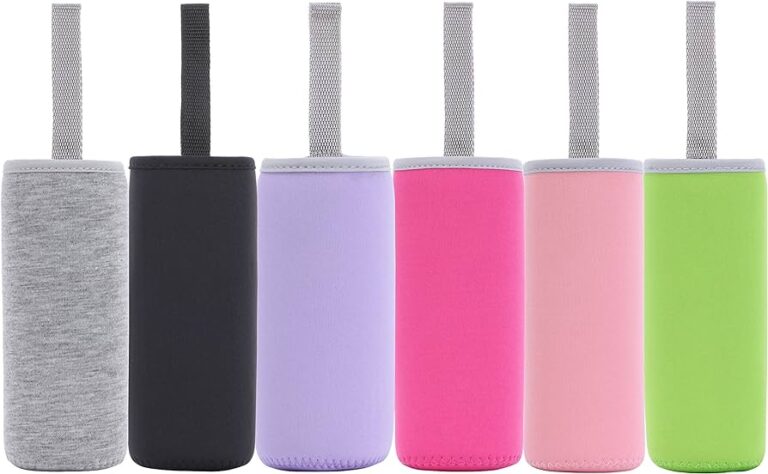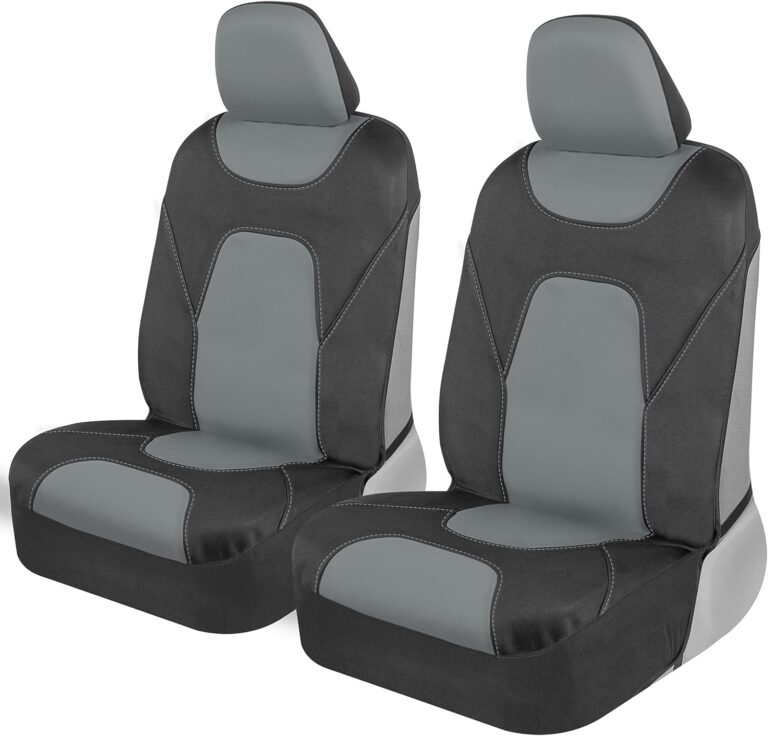How Long Do Neoprene Seat Covers Last? Discover Their Durability!
Neoprene seat covers typically last for several years with proper care and maintenance.
Understanding Neoprene Material
Understanding Neoprene Material: Neoprene seat covers are made from a synthetic rubber material called neoprene.
Composition of neoprene fabric: Neoprene is composed of a mixture of polymers, primarily chloroprene, which gives it its durability and stretchability. It also has a unique cell structure that provides insulation and cushioning properties.
Benefits of using neoprene for seat covers: Neoprene seat covers are highly durable and resistant to wear and tear. They offer excellent protection against spills, stains, and UV damage. Neoprene is water-resistant, making it ideal for outdoor use and protecting against liquids and moisture. Additionally, neoprene seat covers are easy to clean and maintain. They provide a snug and custom fit, enhancing the appearance of your car seats while adding a layer of comfort.
Comparison with other seat cover materials: Neoprene seat covers have several advantages over other materials. Unlike leather, neoprene is more affordable, water-resistant, and easier to clean. Compared to fabric seat covers, neoprene offers better protection against spills and stains. It also has superior durability and does not fade or shrink over time. Neoprene seat covers can withstand extreme temperatures and harsh weather conditions, ensuring long-lasting performance.
Factors Affecting Neoprene Seat Cover Durability
Exposure to sunlight and UV rays can significantly impact the longevity of neoprene seat covers. Prolonged exposure to direct sunlight can cause the material to fade and deteriorate over time. UV rays can also weaken the fabric, leading to cracks and tearing.
The frequency of use and seating friction are important factors to consider. Over time, constant sitting and movement can wear down the neoprene material, causing it to become thinner and lose its resilience. Regular usage, especially in high-traffic vehicles, can contribute to the gradual degradation of seat covers.
The maintenance and cleaning practices implemented also play a role in the durability of neoprene seat covers. Proper care, such as regular cleaning with mild soap and water, can help prevent stains and maintain the integrity of the material. Neglecting to clean spills and allowing liquids to penetrate the fabric can lead to discoloration and damage to the seat covers.
Lastly, the effects of spills and liquid absorption should not be underestimated. Neoprene is known for its resistance to water, but prolonged exposure to liquids can still pose a risk. Over time, repeated exposure to spills can weaken the fabric and compromise its overall durability.
Predicting Lifespan Expectancy
When considering the lifespan of neoprene seat covers, several factors come into play. One indicator is the manufacturer’s durability claims. These claims provide insights into the material and construction quality, giving an idea of how long the seat covers are expected to last. Additionally, real-world longevity reports from users can offer valuable information. Hearing about the experiences of others who have used the seat covers can help determine their durability.
Another factor to consider is the warranty periods provided by manufacturers. Longer warranty periods typically indicate higher confidence in the product’s durability.
Protection Capabilities Of Neoprene
Neoprene seat covers are known for their long-lasting durability and protection capabilities. They offer an excellent defense against water and spills, thanks to their waterproof and spill-resistant features. The neoprene material used in these seat covers creates a barrier that prevents liquid from seeping through and staining or damaging the original seat material. This makes them ideal for those who frequently transport liquids or have children or pets in the car.
Additionally, neoprene seat covers provide reliable protection against heat and cold. Their insulating properties help to keep seats cool in the summer and warm in the winter, ensuring your comfort regardless of the temperature outside. This makes neoprene seat covers a great investment for those living in extreme weather conditions.
Furthermore, neoprene seat covers are highly effective in protecting against dust and stains. The material is resistant to dust accumulation and repels dirt and grime, making it easy to clean and maintain. With neoprene seat covers, you can keep your seats looking brand new for a long time, even with regular use.
Regular Maintenance Tips
Regular maintenance is key to extending the lifespan of neoprene seat covers. Follow these best cleaning practices to keep your covers looking and performing their best:
| Recommended Products | Do’s | Don’ts |
|---|---|---|
| – Mild soap or detergent – Soft bristle brush – Non-abrasive cloth |
– Clean spills promptly – Use gentle, circular motions – Air-dry in a shaded area |
– Use harsh chemicals or bleach – Scrub vigorously – Machine wash or dry the covers |
By using mild soap or detergent, a soft bristle brush, and a non-abrasive cloth, you can effectively clean neoprene covers without causing damage. It’s important to clean spills promptly and use gentle, circular motions to avoid scrubbing too aggressively. After cleaning, allow the covers to air-dry in a shaded area to prevent discoloration or warping. Remember, never use harsh chemicals or bleach on neoprene covers, as they can cause fading and deterioration. Additionally, avoid machine washing or drying the covers to preserve their quality and longevity.
Professional Versus Diy Care
Neoprene seat covers can last for several years with proper care. While professional care ensures longevity and expert results, DIY care can be a cost-effective option for those with time and patience.
When To Opt For Professional Cleaning Services
Neoprene seat covers are a popular choice for their durability and ability to withstand wear and tear. However, over time, they can become dirty and require maintenance to keep them looking their best. For routine care, many car owners prefer to handle the cleaning themselves. This can be a cost-effective and time-saving option. Regularly vacuuming the seat covers and wiping them down with a damp cloth can help remove surface dirt and debris. For stubborn stains and deep cleaning, professional services may be necessary. Professionals have specialized equipment and products that can effectively remove even the toughest stains and odors from neoprene seat covers. Additionally, they can also provide recommendations on proper care techniques to extend the lifespan of your seat covers. Ultimately, the decision to opt for professional cleaning services will depend on the extent of the dirt and stains and the owner’s personal preference for convenience and cost.
Step-by-step Guide For At-home Maintenance
Maintaining neoprene seat covers at home is a straightforward process that can help keep them in good condition. Here’s a simple step-by-step guide for DIY maintenance:
- Vacuum the seat covers to remove loose dirt and debris.
- Prepare a mixture of mild soap or detergent with warm water.
- Dampen a soft cloth or sponge in the soapy mixture and gently scrub the seat covers.
- Rinse the cloth or sponge and wipe off the soap residue from the seat covers.
- Allow the seat covers to air dry completely before reinstalling them.
- Regularly repeat these steps to keep the seat covers fresh and clean.
Tools And Equipment For Diy Neoprene Care
| Tools and equipment | Description |
|---|---|
| Vacuum cleaner | Removes loose dirt and debris. |
| Soft cloth or sponge | Used for gentle scrubbing. |
| Mild soap or detergent | Mix with warm water for cleaning solution. |
Impact Of Environmental Conditions
Geographic influences play a significant role in determining the longevity of neoprene seat covers. Different climates and weather extremes can have both positive and negative effects on the durability of the covers.
In areas with harsh weather conditions, such as extreme heat or cold, neoprene seat covers may experience accelerated wear and tear. Prolonged exposure to intense heat can lead to fading, cracking, and deteriorating of the material. Similarly, extreme cold temperatures can cause the neoprene to become brittle and prone to tearing.
To mitigate the adverse effects of weather extremes, it is recommended to take protective measures. Using sunshades when parking under direct sunlight can help minimize heat absorption and prevent fading. Additionally, applying a suitable protectant or conditioner regularly can help rejuvenate and nourish the neoprene material, enhancing its resistance to environmental factors.
Furthermore, the longevity of neoprene seat covers can vary in different climate zones. Areas with moderate climates tend to be more favorable for the durability of neoprene covers, as they experience less severe weather fluctuations. On the other hand, regions with extreme temperature variations may require extra care and maintenance to ensure the covers last longer.
Frequently Asked Questions On How Long Do Neoprene Seat Covers Last?
How Long Do Neoprene Seat Covers Last?
Neoprene seat covers can last for several years, depending on various factors such as usage, maintenance, and quality. With proper care and regular cleaning, they can typically last anywhere from 3 to 5 years. However, higher-end neoprene seat covers have been known to last even longer, providing durable protection for your car seats.
Are Neoprene Seat Covers Waterproof?
Yes, neoprene seat covers are waterproof. Neoprene material has excellent water-resistant properties, making it highly effective in repelling liquids such as water, spills, and stains. This feature not only helps to protect your car seats from damage but also makes cleaning neoprene seat covers relatively easy and convenient.
Can Neoprene Seat Covers Be Machine-washed?
Yes, neoprene seat covers can be machine-washed. Most neoprene seat covers are designed to withstand machine washing, making them convenient to clean when necessary. However, it is recommended to follow the manufacturer’s instructions and use a gentle cycle with cold water to ensure the longevity and quality of the seat covers.
Do Neoprene Seat Covers Fade Over Time?
Neoprene seat covers are known for their excellent color retention and resistance to fading. However, prolonged exposure to sunlight and harsh UV rays can cause some fading over time. To prevent or minimize fading, it is recommended to park your car in shaded areas or regularly use a UV protectant spray on your neoprene seat covers to maintain their vibrant colors.
Conclusion
The durability of neoprene seat covers largely depends on factors such as the quality of the material and its usage. Generally, these seat covers can last for several years with proper care and maintenance. Regular cleaning and avoiding harsh chemicals can help extend their lifespan.
So, invest in high-quality neoprene seat covers to protect your car seats and enjoy their longevity.
- Can I Get in a Taxi Without a Car Seat? - January 26, 2025
- Can I Get Chlamydia From a Toilet Seat? - January 26, 2025
- Can I Get an Uber With a Car Seat? - January 26, 2025






